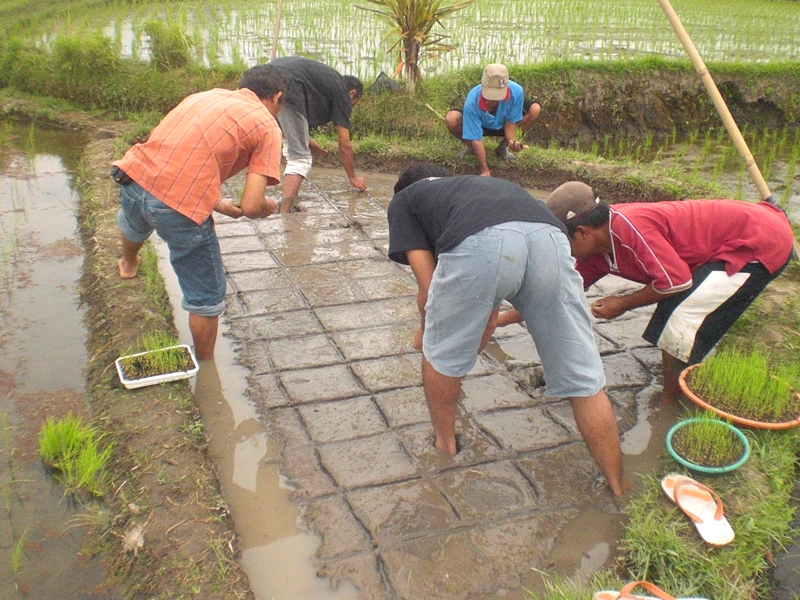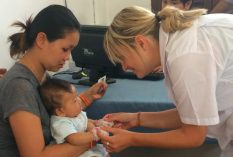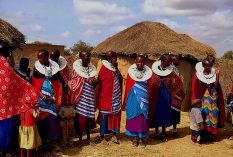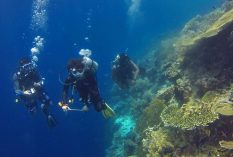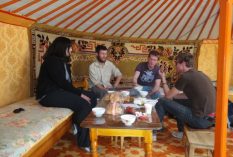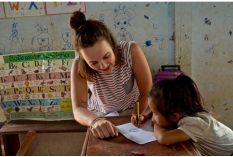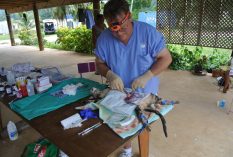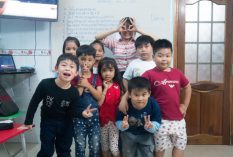Week 1
I arrived on Monday the 13 th of March at 3 am, Chakra came to get me from the airport. On my first day, i went with Chakra to the Alchemy Academy and he explained me that they are building a worm toilet connected to a pool and a watering system, it is a closed water cycle. A worm toilet consists of the toilet connected to an underground tank with two compartments. In the first compartment a layer of mulch and worms is put in. This compartment is aerated and the worms take the pathogens out of the feces. The liquids flow into a second compartment which is not aerated, here an anaerobic reaction takes place and the clean, filtered water flows into the pool. The amount of methane produced in the anaerobic reaction is too small to capture and is just released in the ambient air.
After that we met with two different farmers, because Chakra had some tools for them and they discussed some business. It was very interesting to see how the balinese farmers live. They do not have one big house, but at least 4 small buildings, one house for the kitchen, one where the children sleep, one where the elderly sleep and one where the head of the household sleep. Behind this area is the house-temple.
On the second day Chakra had a meeting with an American couple that wanted to buy a place and start a restaurant. They asked Chakra to consult them, about the place, the produce and the costs. I came along to that meeting, it was interesting to hear all the things that need to be considered.
After that we went back to the Alchemy Academy and we shoveled some sand, which was hard because it was very warm.
Right after that i could come along to another meeting of Chakra. He met with two other guys which are also in the rice selling business. The goal of the three men is to give the power and independence back to the rice farmers. This means that there are as less people between the farmer and the rice buyer.
On the third day, Wednesday, we went again digging in the Alchemy Academy and in the afternoon we went to Chakra’s rice field nearby, but it started to rain heavenly and we quickly returned home.
On Thursday we went to Chakra’s rice field and did some weeding, this means we pulled all the unwanted plants out. In the afternoon we drove for 1.5 hours to The Green Camp in the mountains and helped building a chicken tractor out of babus. Chakra showed the teachers of the odyssey school how to build the chicken tractor and the solar dehydrator. A chicken tractor is a big cage for chicken, without a flor or bottom part, this way the chicken search for food in the ground and turn the ground around and aerate the ground. This is good to prepare the ground to plant some vegetables.
On Friday we did some more weeding of the rice field.
Week 2
On Monday the 20th of March we first mulched the rice fields, meaning we put the dried rice shells from the previous harvest on the field. This prevents the new weed from growing and it brings silica to the ground, which is good for the growth of the rice. After that we went to Alchemy Academy and did some more shoveling, but this time we buried the pipe coming from the septic tank (wormery). The water goes into a little garden for trees and vegetables. In the afternoon we went to some farmers house, because Chakra was suppose to teach some women about moringa, the process of making it and the packing up. However the women never showed up, so we did the packing up. This morgina is sold in local markets, but Chakra has more Moringa trees, which he exports to Germany. After that we went to a farm, where they grow ducks and chickens and chakra bought 10 ducklings. The ducklings were released into the rice fields, they eat the rest of the weed and they have protection and food.
On the next day we went early to the green camp, because Chakra was giving some lectures to a class from Singapore. The first lecture was about the rainwater that is gathered on the rooftop of the largest building. However the rain water is too clean to be drinking water, it will absorb minerals from our body. The rainwater can be used for every other use, showering, watering plants, washing… It is important that the water is stored under the surface and the tank has a U or V shape and is sealed with a black plastic membrane. This way the water is cold and not exposed to direct sunlight, so that no algae grows. The next lecture was about the bees, in a small hanging box bees have a hive. Per hive is only one queen, then there are the drones and the works. The works decide which role new born bees take, by what they feed them with. These bees give two small bottles of honey per month. After that Chakra talked about the cows, they give 30 kg of feces per day and for four cows this can be used to produce biogas. After that the children learned about composting weed, and how beneficial it is to put it back on the ground to rot.
After that Chakra left, but i stayed for three nights at the green camp. Sadly it rained all afternoon, so we did not work.
On Wednesday on the Green Camp we planted some tomatoes and broccoli. We made a little hole in the ground and put some compost in it and then replanted the plants from a green house. After that we put some hay on the ground around the plants to protect them and to hinder new weed from growing.
On Thursday and Friday we did the same thing we replanted kale, radish, salad, turmeric, bell pepper and mint.
Week 3
On Monday we started work with weeding the rice fields. After that we went to a construction site a little outside of ubud. Chakra is helping to build an ecologic house, meaning compost toilet, some electricity is generated from a river and bamboo cement. We helped building the floors, the bamboos are put horizontally and hold by steel contruction at the end. Then cement is put around the bamboo, this way the cost of the construction is way lower and more stabile. The cement has to be put in at the same day, so the cement is more stabile.
On Monday evening we celebrated the Balinese new year.
On Tuesday was the silent day, we could not leave the house and in the evening we could not turn on the lights.
On Wednesday we went to alchemy academy and we put the worms in the compost toilet. And we planted palm trees and lemongrass on the subsurface flow area, this is where the water from the showers and the sinks comes out and flow into the ground.
On Thursday we went to a workshop, where Chakra explained to 3 farmers how to plant rice the organic way. First you have to separate the good seeds from the bad ones. This can be done by buoyancy, if the seeds float in some sugar water they are not good seeds. The bad seeds can still be planted and used to feed the chickens and goats. After soaking over night, the good seeds are first put onto banana leaves with some compost and volcanic sand. This way the seeds can grow roots but for the replanting the roots are easy to take out, they do not break. After several days the seeds are ready to be planted in the field, and for the organic rice only one seed is planted at one point, because other rice farmers put several seeds in one place. After the first weeding of the rice field a liquid fertiliser can be put on the field. This fertiliser consists of banana stem, bamboo, and some legumes. The banana stem brings the potassium, the bamboo the silica and the legumes the nitrogen. This is chopped up finely and put in the sugar water with a little bit of EM4, this is a microorganism.
On Friday we went with Chakra to his rice fields in the west of bali, Jatiluwih. Chakra had a meeting with the farmers working on his fields. We went for a walk around the unesco heritage protected rice fields and it was very beautiful.
Week 4
On Monday in the morning we did some weeding and cut gras where the chickens live. In the afternoon we went to bought some young bamboo and plant it with lemongrass on the subsurface flow. Here you should not plant trees with fruits, as the water is not 100% clean. It’s the water from the sink and the showers. We also got some hay to put in the compost toilet for the worms.
On Tuesday the Balinese prepared for the next day, Galungan. So we did not work on Tuesday.
On Wednesday in the morning we went to the temples to celebrate the balinese revolution against ‘the mad king’ in the 12th century. In the afternoon we drove north to consult a water catchment system at a hotel. They have a compost toilet, but the rainwater hinders that the compost toilet works correctly. After that we went to see a hydro powered pump. It is very basic, but it works.
On Thursday we went north to the Beratan Lake to consult farmers on how to plant raspberries and how to get organic certificated. Their fields are in a slight slope, so they should plant in a perpendicular manner to the slope. This way the rainwater does not do any damage to the field.
On Friday was not much work to do, so Chakra showed us some pictures and videos of his projects. He build different types of compost toilets, dry and wet and different compositions. He explained us how his oven for drying the rice works, plus how it also treats bamboo. He also showed us pictures of hydro powered and wind powered generators. It was very interesting.
This week were three days of celebrations: the day for preparation, Galungan and the celebration of the rice field harvest. So we did less work this week.
By Claire Heuschling 2017

